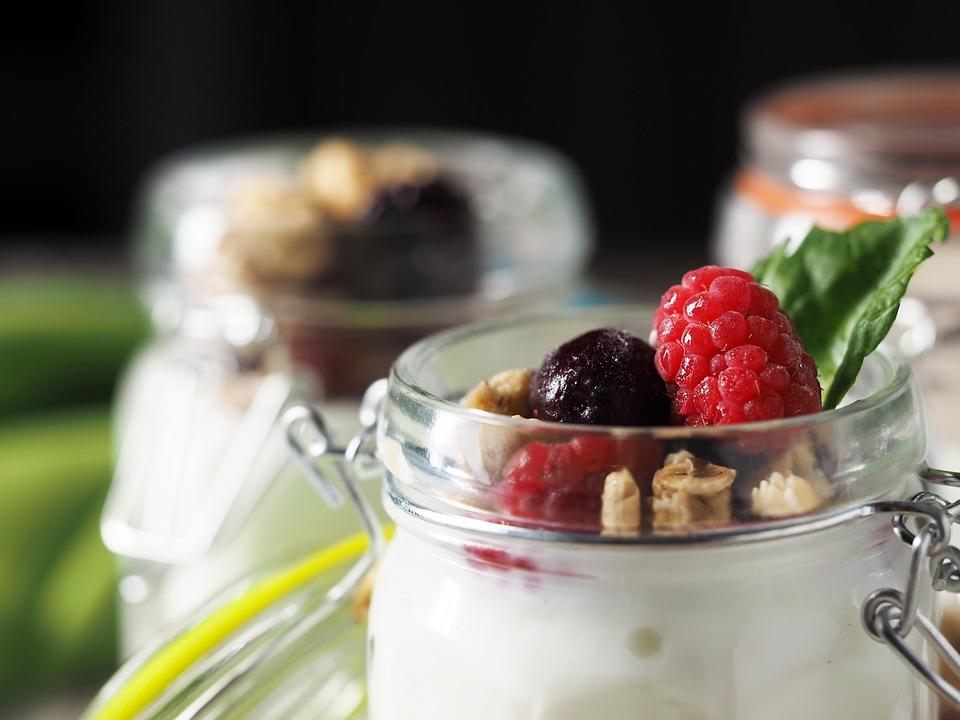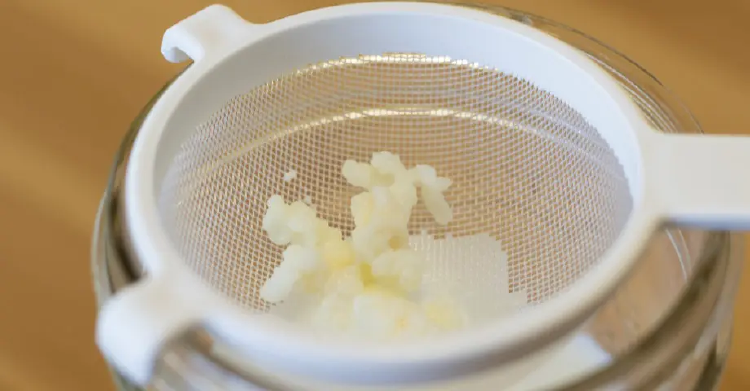
Whether you've been on the green line for some time now or you are just starting to discover this new world, you' re surely familiar with the word kefir and its benefits for keeping a good health. But what is Kefir? Where does it come from? Why it went so popular? Why is so beneficial to our health? How can I prepare my own kefir? We'll try to explore all of these kefir questions in this article. And there's more... We'll give you a few-ingredient, easy-to-follow, home made kefir recipe and tips for you to make your own kefir at home!
According to modern science, Kefir is a fermented milk beverage obtained by fermenting milk with kefir grains, that originated in the Caucasus Mountains. The word kefir is derived from the Turkish word keyif which means “good feeling.” Kefir grains look like "small cauliflower florets or cooked rice" they have a length of 10 to 30 mm and an irregular shape.
Their color is white to yellowish in and they have a firm texture and slimy appearance. Kefir bacteria contain several species of lactic acid bacteria, yeast, and acetic acid bacteria which have great benefits to our health.
Kefir can be traced back to many centuries ago to the shepherds of the Caucasus Mountains. These shepherds discovered that fresh milk carried in leather pouches would unexpectedly ferment into a beverage.
In the ancient Caucasian Mountains, legend has it that kefir grains were a gift from Mohammed the Orthodox people. Not only he gave them the kefir grain but he also secretly shared how to use them and prepare them. Mohammed's condition on this was that the secret magical preparation of kefir shouldn't be given away to anyone, otherwise their "magic strength" would be lost.
This ancient legend may explain why kefir grains and the method for kefir preparation have been surrounded by mystery for so long. For most of what we call "recorded history", kefir was rarely known outside the Caucasian Mountains, even though Marco Polo mentioned it in several of his travels.
Nowadays, some mystery around kefir and its preparation has been unveiled. Actually, this self-carbonated beverage still very popular in Russia, southwestern Asia and Eastern and Northern Europe, and has recently gained some popularity in the United States thanks to all this renewed attention to what we eat or drink and to finding healthier versions of what we regularly intake.
Probiotics, in this sense have rocketed in popularity since the many benefits they have for our health. Check this post: Why Probiotics are good for you? Learn their Health Benefits
There are two different types of kefir:
Each type of kefir has unique characteristics and their preparation slightly differs. So if you're on the way of adding some probiotics to your daily routine, check which of the following preparations suits you best!

Among the many advantages of adding kefir to your daily diet, we can mention a few:
Kefir is a fermented drink, traditionally made using cow’s milk or goat’s milk. The kefir grains are added to the milk and what you obtained after a patient process is a probiotic drink that is highly nutritious. Let's bear in mind that kefir grains are not exactly grains, but more grain-like colonies of yeast and lactic acid bacteria that resemble a cauliflower in appearance.
Over approximately 24 hours, the microorganisms in the kefir grains multiply and ferment the sugars in the milk, turning it into kefir. The "grains" are removed form the final beverage so that you can use this colony again to prepare more kefir. In other words, kefir is the drink - very similar in taste to yogurt , by the way- but kefir grains are the starter culture that you use to produce it.
According, to the USDA (U.S. Department of Agriculture ) if you take a 6-ounce (175-ml) serving of low-fat kefir you will get:
In addition, kefir is pretty low in calories, carbs and fat. The amount of fat actually will depend on the type of milk that you'll use for its preparation.
If you are veggie or vegan, you can also incorporate kefir in your daily diet. There's a wide stock of plant-based kefir in the market as well. Dairy-free versions of kefir can be made with coconut water, coconut milk or any other sugary drink and the nutritional value will slightly differ from that of dairy-based alternatives.
Kefir is extremely beneficial for your gut health. Milk itself is known for being a good source of protein and calcium, and kefir is no different. But it has the extra benefits of probiotics. Probiotics are known as ‘friendly bacteria’ that may help you ease IBS (Irritable Bowel Syndrome) symptoms such as bloating and general digestive distress. So if you regularly struggle with some digestive problems, you may consider including kefir to your diet.
Consuming kefir on a regular basis has also proved to be great for blood pressure, cholesterol balance and blood sugar management. What's more, depending on the variety that you use, kefir grains may contain 30 or more strains of beneficial bacteria and yeasts. Some of the major strains include the lactobacilli – or lactic acid bacteria (LAB), a very important group of "friendly bacteria" that brings benefits to your immune system.

Common dairy foods contain a natural sugar called lactose. It has become quite common that many people, especially adults, cannot break down and digest lactose properly, which leads to lactose intolerance.
The lactic acid bacteria in fermented dairy foods — like kefir and yogurt — turn the lactose into lactic acid, so these kefir is much lower in lactose than milk and it contains also a group of enzymes that can help break down the lactose even further. Therefore, kefir is generally well tolerated by people with lactose intolerance, at least compared to regular milk. In short, if you are lactose intolerant you may consider trying kefir, right?
Keep in mind that if you are vegan or vegetarian, or you just don't like dairy products, it's possible for you to make or get kefir that is 100% lactose-free by using coconut water, fruit juice or another non-dairy sugary drink as a base for the ferment.
You may be interested at: A Complete Guide to Lactose Intolerance: Causes and Symptoms
Osteoporosis is a current major problem in Western countries. It is characterized by a relatively slow deterioration of bone tissue and is particularly common among older women and its development may link to a poor intake of calcium in your diet.
Including an adequate calcium intake is one of the most effective ways to improve bone health and slow the progression of osteoporosis.
Full-fat kefir is not only a great source of calcium but also of vitamin K2 — which plays a central role in how our body absorbs calcium. Calcium and vitamin K2 if complemented adequately can reduce the risk of bone fracture up to 80%, according to medical research.
Last but not least, the greatest advantage of kefir is that it's pretty easy to get at the groceries, but if you are an enthusiastic experimentalist you can also make your own kefir at home!
If you do not trust very much the quality of store-bought kefir, you can easily make it at home. You may consume it as a drink, you may add fruits to it. In any version, kefir is most definitely a delicious choice and it's really easy to prepare!
You may get kefir grains at some health food stores and supermarkets. And you can also find many blog posts and videos that teach kefir production, but the process is always very similar and simple. We invite you to keep on reading and find a very simple and low cost recipe and tips to prepare and store the most delicious kefir in the comfort fo your own home.
I hope we've persuaded you enough to try this! Kefir is easy to make safely at home, you don't need much equipment either so it’s definitely worth adding to your diet. You may or may not know that kefir is well known for having a strong, sour flavor that doesn't suit the taste of may people but it’s very easy to control the process so it’s delicious and mild. This recipe is little time consuming, too. It will take no more than five minutes per batch, from start to finish!
Follow carefully the following steps to obtain the perfect kefir:
Finally, if you want to make more kefir you may rinse out the jar, put the grains back in (no need to wash them), fill it up with milk again and leave at room temperature to make some more.

Once strained, keep the kefir in the fridge. This will slow down the process of fermentation by the microbes. In good conditions, you can keep it for about 7-10 days. It will not ‘go off’ as such, as it is already fermented, but the flavor might become rather strong. A nice alternative is that you make a larger batch once a week if you don’t want to make it daily.
In between processes, keep the grains covered in a little jar of milk on the worktop for up to a week or up to three weeks in the fridge. Change the milk if you’re still not using them otherwise you'll notice a stronger flavor in your next kefir.

As we said, if you can afford and find at your place some organic milk, go for it. Any regular fresh animal milk works though, from skimmed to full fat, goat, cow or even UHT. The higher the milk’s fat content, the thicker the kefir.
But please, do use fresh milk that is not on the turn; and be aware of pasteurized milk: it contains some non-harmful bacteria that can grow at low temperatures and eventually change the flavor of the milk – this can interfere in the process and may result in your kefir having a not ver pleasant taste.
As we mentioned already, if you are a vegan or veggie, or you just can't tolerate o like dairy products, you can make kefir with plant-based alternatives like coconut, soya or oat. Whichever you choose, it needs a high calorie and sugar content as this will be the microbe’s source of nutrition anf growth.
Soya milk is good for an excellent thick kefir, and the grains will usually grow in this medium. Canned coconut cream is a better choice than coconut milk, and gives a thick, sour, almost yogurty consistency; if possible, choose an organic brand as these have no additives. Probably, fabricating plant-based kefir can be a little harder because you have to rely entirely on how kefir grains will work in this not dairy media. If you notice that they are not multiplying or not growing much, try refreshing them in some dairy milk for a few days for better and more delicious results!
What do you think? Are you ready to taste and prepare your own kefir? It's worth the shot, right?
You may be interested at: Easy Plant-Based Recipes for Dinner & Best Bowls to carry them